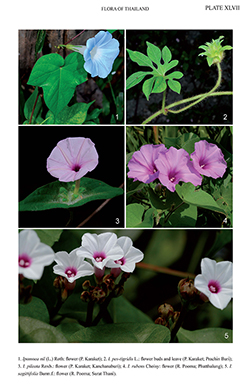e-Flora of Thailand
Volume 10 > Part 3 > Year 2010 > Page 423 > Convolvulaceae > Ipomoea
23. Ipomoea sagittifolia Burm.f.
Fl. Ind. 50. 1768; Gagnep. & Courchet in Lecomte, Fl. Indo Chine 4: 260. 1915; Staples & Jacquemoud, Candollea 60: 451. 2005. Plate XLVII: 5.
Accepted Name : This is currently accepted.
Synonyms & Citations :
Description : Perennial herbs, from stout root, axial parts spreading hirsute or glabrous; stems twining or prostrate, 1–3 m. Leaves elliptic-ovate or reniform to circular, upper leaves sagittate or hastate, 2–6 by 2–5 cm, glabrous, base deeply cordate or hastate, margins ciliolate, apex attenuate or abruptly acuminate; petiole 1–3 cm, sometimes minutely tuberculate. Inflorescences cymose, crowded; peduncle 2–8 cm, thick, often flattened and verruculose apically; bracts persistent, ovate or oblong, ca 2 mm; pedicel 0.5–0.6 cm, sparsely verruculose. Flower: sepals ovate or elliptic-oblong, equal or inner longer, 4–7 mm, glabrous, apex obtuse; outer 2 sepals verruculose, margin paler; corolla subsalverform, 2.5–4 cm, white or pale purplish, darker in tube, limb weakly 5-lobed; stamens included; pistil included, ovary glabrous. Capsule depressed-globose, 6–7 mm, glabrous. Seeds pale greyish-white tomentellous, margin often with longer cobwebby hairs.
Thailand : NORTHERN: Phitsanulok; NORTH-EASTERN: Maha Sarakham; CENTRAL: Nakhon Pathom, Krung Thep Maha Nakhon (Bangkok), Samut Sakhon; SOUTH-EASTERN: Chachoengsao; PENINSULAR: Songkhla.
Distribution : Africa, India, Sri Lanka, Myanmar, China, Laos, Vietnam, Malaysia, Indonesia (Java – type), New Guinea, Australia, Pacific Islands.
Ecology : Weedy in vacant lots, roadsides, waste ground and disturbed areas, often in damp to wet soils, sea level to 25 m alt. Flowering: July–December; fruiting: December.
Vernacular : Sa uek (สะอึก)(Bangkok).
Notes: An ubiquitous species in urban waste ground in Bangkok and central Thailand, despite the few collections documenting its distribution and abundance. The subsalverform, pale purplish corollas suggest nocturnal flowering and a moth-pollination syndrome although the pollination biology has not been reported.

